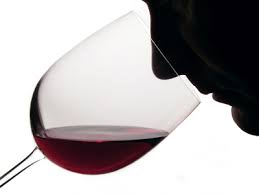Editor’s Note: This is an exert from author John Hailman’s book The Search for Good Wine. This particular chapter was written on February 25, 1987.

A veteran wine-taster once observed that in judging wines, “one peek a the label is worth years of experience.” Barring such help, how do you go about evaluating a wine? This past fall, I got the chance to compare some of the better techniques in action as a judge at the Atlanta International Wine Festival.
One of the world’s largest tastings, the 1986 Atlanta event, attracted 1,621 wines from all major wine-producing countries. The wines were evaluated “blind” by panels of judges over 11 evenings of tastings. My panel, six of us, was assigned to taste in a single evening 38 young Chardonnays with retail prices from $10 to $15.
Seated at a white tablecloth under good lighting, we followed the classic wine-tasting progression: swirl, sniff, sip and spit. Swirling the wine causes its “legs” to stream down the inside of the glass, revealing its weight or “body” (this is all so personal). Swirling also causes aeration of the wine, releasing its volatile esters and other elements into the air in what is called “breathing”.
Speeding up the aeration of wine allows tasters of judge its aroma and bouquet, known in wine jargon as “getting the nose”. Authorities differ on how you best get a nose. Famed wine auctioneer Michael Broadbent recommends “a vigorous sniffing”. Heavyweight oenologist Maynard Amerine of Cal-Davis, the Oxford of wine-making schools, prefers a “light inhale”, so you don’t suffer “olfactory fatigue” (tired nostrils). Those at my table seemed to use both methods, sniffing more vigorously only those bouquets they really liked.
Nearly every wine was visually correct and we differed a little in our views of their appearance. But in getting the nose, we parted company. From too many years of living in France, I cannot stop making that gargling sound French-tasters make. It is wonderfully revealing of the wine, though, and only moderately hard to learn without choking. You hold a small mouthful of wine, then inhale vigorously over your tongue, creating a sort of mist of wine in the back of your mouth.

You then close your mouth and breathe out quickly through your nose without swallowing. This causes the mist to go up the back of your nasal passages, where your most accurate olfactory nerve endings are. The taste of wine being roughly 75 percent smell (you can’t “taste” anything when you have a cold”, this exercise is probably the most important part of any tasting. Those at my table had the drill down pat, but some used it too sparingly in my opinion.
The downside of this important practice is the noise it makes, which my wife describes as “gurgling”. My daughters love it and call it “making the wine noise”. Less charitable friends, at whose tables I have demonstrated it, liken it to a drowning sound or to a horse trying to drink and eat oats at the same time. Unfortunately, once you get the hang of it, you tend to do it whenever you taste a wine.
Our panel really parted company in the last stages of the tasting, splitting neatly into two groups known in the trade as “dry-bucket” and “wet-bucket” tasters. We each had before us our own genuine plastic spittoon bucket with about two inches of lentil-sized rocks at the bottom to prevent splashing. Others use sawdust or wood shavings. Since we were to evaluate 38 wines in about two hours, I knew I had to join the we-bucket brigade if I intended to complete the tasting without bursting into song.
The only bad after-effect of the Atlanta tasting was the next morning, when my tongue was so red and swelled up from being doused in acidic young wines that all I wanted to soak it in was milk.
 John Hailman of Oxford is a regular contributor to HottyToddy.com on two subjects: Law and Wine. Now retired from both his “day job” as a federal prosecutor in Oxford after 33 years and his “night job” of 25 years as a nationally syndicated daily columnist in more than 100 daily papers on wine, food and travel for Gannett News Service and the Washington Post, Hailman will cover both topics under the titles of The Legal Eagle and Wine Tips of the Week. HottyToddy.com will also run periodic excerpts from Hailman’s upcoming book of humorous legal stories, From Midnight to Guntown: True Crime Stories From A Federal Prosecutor in Mississippi. Hailman now teaches Federal Trial Practice and Law and Literature at the University of Mississippi.
John Hailman of Oxford is a regular contributor to HottyToddy.com on two subjects: Law and Wine. Now retired from both his “day job” as a federal prosecutor in Oxford after 33 years and his “night job” of 25 years as a nationally syndicated daily columnist in more than 100 daily papers on wine, food and travel for Gannett News Service and the Washington Post, Hailman will cover both topics under the titles of The Legal Eagle and Wine Tips of the Week. HottyToddy.com will also run periodic excerpts from Hailman’s upcoming book of humorous legal stories, From Midnight to Guntown: True Crime Stories From A Federal Prosecutor in Mississippi. Hailman now teaches Federal Trial Practice and Law and Literature at the University of Mississippi.

